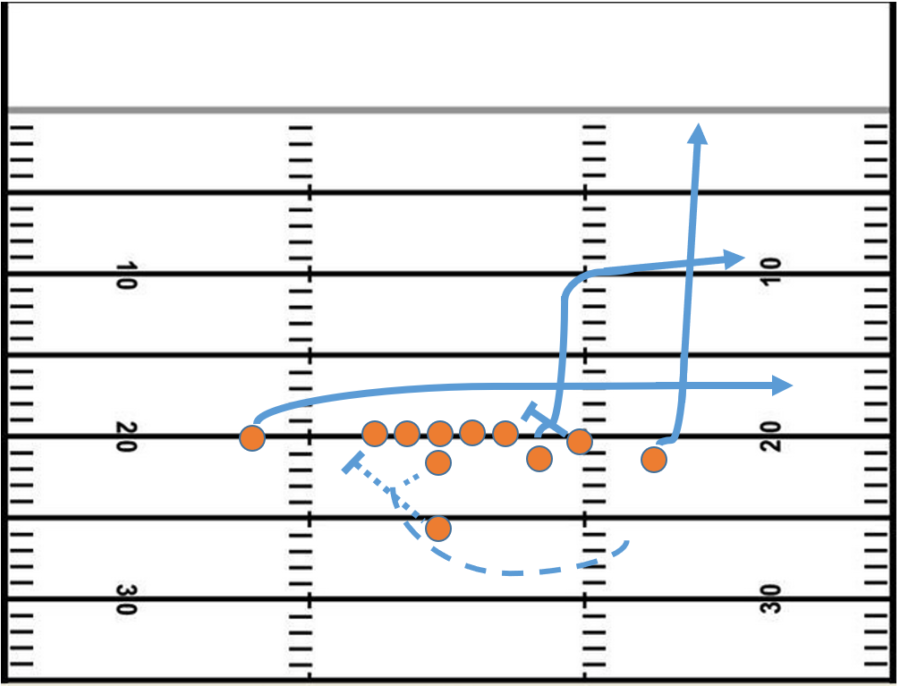Week 16 Film Review: Rams Rollout - A Quintessential Play
Merry Christmas! The NFL season is drawing to its dramatic close, fantasy football champions have been crowned and there is just one more day of regular season football to go.
At this special time of year, comes a special type of article. We are going to take a look at a quintessential play. A staple play that is right at the top of the list for a team – or multiple teams – which you should understand and learn to recognise.
This week the Los Angeles Rams travelled to San Francisco for a divisional game, and there was one play that I noticed was incredibly successful for the visitors, particularly in the first half.
The element of their playbook I want to look at is their play action rollout passing game.
Todd Gurley is an incredibly talented running back and he has been given the reigns to get his full workload again, which has been effective – albeit too little too late, I’d suggest – and they have began to return to the running game that we came to expect last year in their Super Bowl-reaching campaign.
Their play action game is built around the horizontal zone running game that makes Gurley so potent, and therefore most of their play action is in the form of getting QB Jared Goff out in a rollout through bootlegs, often naked bootlegs.
Let’s take a look at a play design of one of the variations of their rollout passing scheme.
Early in the game, Sean McVay called one of the most effective bootleg passing concepts, the flood concept.

This concept is the bread and butter of play action, and a favourite of McVay’s offense, cutting the field in half, rolling Goff out to the right, and flooding that side.
The flood combination consists of three levels of attack. The outermost receiver runs a go route to clear out the deepest defender(s), and then the two other receivers run to the sideline at a shallow and intermediate depth. The drag route from the far side of the field allows for a slightly delayed timing that will come across as Goff boots out to the right. The deeper route, a bench route or sometimes a corner route.
If there is a defender who drifts back and covers the intermediate route, the drag route will get open. If the defender sits low down to stop the drag, the intermediate route will get open behind him.
The flood concept can work against every type of zone coverage, as long as you can make the read and put the ball in the space. On this particular occasion, it was tight end Tyler Higbee who got open on the bench route.
Goff gets out of the pocket on the bootleg, and it gives him an angle to just make that vertical read. Robert Woods clears out and Tyler Higbee gets open for a nice gain.
Running the bootleg makes it easy to process the reads by cutting the field in half, and then the movement of the QB immediately causes an issue for the defense, who now have to try and cover three different areas in the same third of the field, as everyone scrambles to close whatever angle and fill whatever zone they can.
Not every play has to be the same, but the key to the rollout play will always be the same, the routes and the QB both moving horizontally, parallel to one another.
The first touchdown of the game came on another play action rollout, with three routes all to the left sideline. This play broke down a bit after some good defense, but another key to this type of play is that while the defense is scrambling to follow the QB, he can see everything, and a smart receiver can get open off script, as Brandin Cooks did on this play.
The Niners actually had a similar type of situation on the touchdown to George Kittle in this same game. When the QB moves horizontally and the defense follows, it can take just a step or two back in the opposite direction to get open, like both Kittle and Cooks did.
After changing it up on the touchdown, the Rams actually ran the exact same play as the first one we looked at again in the fourth quarter. It was the same formation, the same concept and design, and the same person got the football. It’s unusual that you can run the identical play successfully twice in the same game, but this concept allows you to rely on it because they really can’t defend it in zone coverage if you run it right.
You can see here that it is literally the same play, and the same outcome.
This in of itself is proof of how effective the play is, and shows exactly why it is so popular. This play is one of quintessential play designs and concepts of play action not only for the Rams but for any team in the NFL. The Rams are incredibly proficient with it but any team could run this play, as it is a true staple of play action.
Now, next time you see a quarterback bootleg out of the pocket on a PA passing play, you will know to keep an eye for crossers and the three-depth route combinations, such as flood, that will take advantage of the scrambling defense.

Tyler Arthur
NFL Film and Prospect Analyst
A graduated Journalism student, Tyler also writes for Read American Football and Gridiron Hub. He played Wide Receiver and eventually Quarterback for his university team at DMU, and is now using his knowledge and passion for learning to dive deeper into the analysis of X’s and O’s in the NFL.
Image Credit: Dan Gorelov
